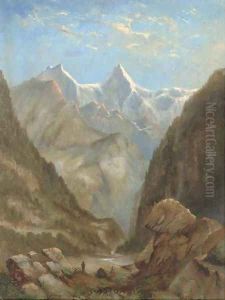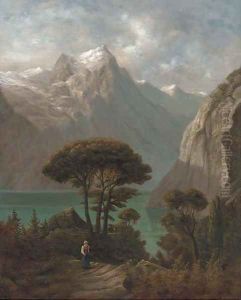Alexander Calame Paintings
Alexander Calame was a Swiss landscape painter born on May 28, 1810, in Vevey, Switzerland. Orphaned at a young age, Calame was initially apprenticed to a banker, but his interest in art was evident early on, and he was subsequently apprenticed to the landscape painter François Diday. Under Diday's guidance, Calame developed his artistic skills and eventually became one of the leading landscape painters of his time, focusing primarily on the majestic Alpine scenery.
Calame's work was characterized by a dramatic sense of scale and an emphasis on the sublime aspects of nature. He often depicted the Swiss Alps with a sense of grandeur and awe, capturing the various moods of the landscape through different seasons and times of day. His paintings were marked by meticulous detail, a keen observation of natural phenomena, and a profound respect for the power and beauty of the natural world.
Calame's success was not just limited to Switzerland; he gained considerable fame across Europe. His work was exhibited in Paris, where it received praise for its technical proficiency and emotional impact. He also found patrons among the European elite, including the Russian aristocracy, which helped him achieve financial stability and allowed him to open his own studio in Geneva.
Throughout his career, Calame also worked as an etcher and lithographer, creating prints that further disseminated his images of the Swiss Alps. He taught at the Geneva School of Drawing and had many students who carried on his tradition of landscape painting.
Alexander Calame's life was marked by his dedication to capturing the essence of the Swiss landscape. His work played a significant role in the development of the Swiss national identity in the 19th century, as his paintings became emblematic of the country's natural heritage. Unfortunately, his health declined in later years, and he suffered from a painful illness that limited his ability to work. Calame died on March 19, 1864, in Menton, France, while seeking a better climate for his health. His legacy lives on through his influential landscapes, which continue to be admired for their beauty and technical mastery.

